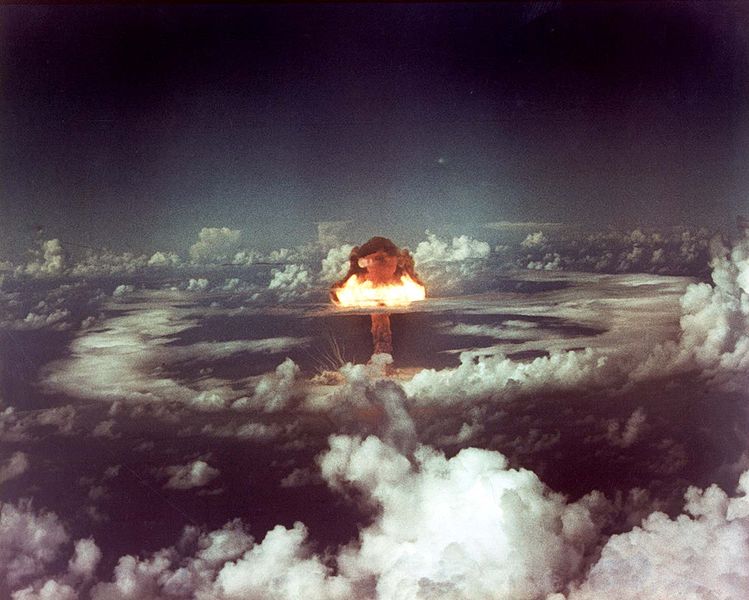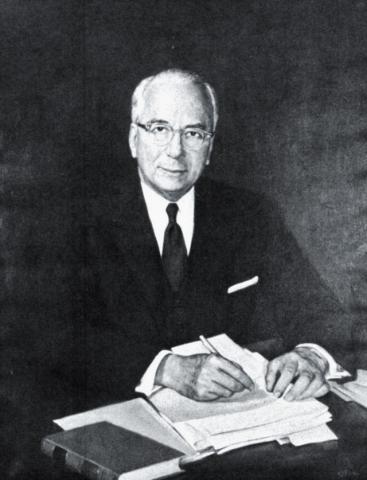In 1954, J. Robert Oppenheimer was stripped of his security clearance by the Atomic Energy Commission (AEC). The AEC, led by Commissioner Lewis Strauss, held a hearing to investigate Oppenheimer’s past Communist Party associations and deemed him a security risk. It marked the conclusion of a bitter campaign waged against Oppenheimer by the proponents of an expanded American nuclear arsenal.
One of the more bizarre components of the campaign was the effort to undermine Oppenheimer’s patriotism in a spurt of magazine articles published in the run-up to his investigation. Perhaps the most provocative was the 1953 article accusing Oppenheimer of being the leader of a cabal of scientists scheming to undermine the policies of the American military.
In its May 1953 issue, Fortune magazine published an article entitled “The Hidden Struggle for the H-Bomb: The Story of Dr. Oppenheimer’s Persistent Campaign to Reverse U.S. Military Strategy.” Though the article was published anonymously, it was written by an Air Force reserve officer named Charles J.V. Murphy in collaboration with Strauss himself.
Oppenheimer had clashed with Strauss and the Air Force for years over issues such as the development of the hydrogen bomb. Oppenheimer chaired the General Advisory Committee of the Atomic Energy Commission, which in 1949 recommended that the United States not pursue thermonuclear weapons. He did modify his position once it was clear that it was possible to develop these weapons (as physicist Charles Critchfield recalled, Oppenheimer deemed the Teller-Ulam H-bomb design “technically sweet”).
Oppenheimer also angered the Air Force by favoring the development of small, tactical nuclear weapons that could be used on the battlefield. This proposal seemed to fly in the face of Strategic Air Command’s desire for a substantial nuclear arsenal to provide “massive retaliation” in the event of a conflict with the Soviet Union. During the early part of the Cold War, many American officials endorsed the notion that the military should possess as many bombs, with as much power as possible. Such a strategy encouraged the development of thermonuclear weapons. As the Air Force and the rest of the military became convinced that there was no other way to fight the Cold War, figures like Strauss and Murphy viewed Oppenheimer as a barrier to progress, and possibly even a Soviet agent.
The article asserted, “J.R.O. [Oppenheimer] is the instigator of a kind of conspiracy to defeat the idea that the strategic bombing unit of the air force has the answer to our defense.” It charged that Oppenheimer was one of the leaders of group ominously titled “ZORC,” an acronym derived from Oppenheimer’s last name as well as those of his alleged conspirators, Jerrold Zacharias, Isidor I. Rabi, and Charles Lauritsen. In addition to its four leaders, the mysterious ZORC group purportedly included about two dozen more physicists. According to the article, ZORC met in secret during the spring of 1952 with a singular goal: to create a nuclear air defense model that would “undercut the ‘Deterrent-Retaliatory’ argument.”
The article bemoaned, “Without the knowledge of the Air Force, ZORC…prepared to test these theories at the [MIT] Lincoln Laboratory.” The implication was that Oppenheimer and his cohorts were rogues who considered themselves too prescient to be confined by the military, with potentially deadly consequences. Indeed, the article framed their opposition as “a life-death-struggle.”
Unsurprisingly, the article vehemently supported the Air Force-endorsed preference for thermonuclear weapons. Murphy argued, “For the U.S., at this juncture in world history, to throw away its strongest weapon merely because it is an offensive weapon is a naïve way to go about ridding the world of war.” The article went out of its way to praise Strauss for his “courage” and “sixth sense” about the hydrogen bomb.
It is difficult to estimate how much of an impact the Fortune article and others like it had on the American people. The prominent columnist Joseph Alsop, a friend of Oppenheimer’s, referred to the ZORC article as a “rich compost of hints, inaccuracies and special pleadings.” It was not the only effort to cast atomic scientists in a suspicious light.
The ZORC moniker was reminiscent of the “Scientist X” nickname attached to former Oppenheimer protégé Joe Weinberg, who was investigated by the House Un-American Activities Committee (HUAC). Weinberg’s investigation centered on meetings he had with California Communist Party officials during the 1940s where he allegedly discussed the Berkeley Rad Lab’s contributions to the Manhattan Project. Ardent anti-Communists in HUAC and the media latched on to the ominous epithet “Scientist X,” which opened Weinberg up to outlandish allegations of hand delivering uranium to the Soviet Union, among other charges.
Nevertheless, when Oppenheimer was eventually investigated by the AEC, the ZORC allegations became evidence against him. David Tressel Griggs, a witness for the Air Force during Oppenheimer’s hearing, described a scene where Zacharias hosted the inaugural ZORC meeting, writing the acronym on a chalkboard and outlining a plan to abolish or redirect the Strategic Air Command. Even though Griggs himself admitted, in an FBI report at the time, to being “somewhat confused concerning this matter,” the ZORC account remained present in the AEC’s consciousness.
Today, the ZORC allegations may seem bizarre. Yet, strange as it is, the article exemplifies the bitterness of the disagreement between Oppenheimer and the Air Force over America’s Cold War policies. These kinds of charges, fueled by Lewis Strauss’s tremendous desire to undermine Oppenheimer and the paranoia of the McCarthy era, led to Oppenheimer’s downfall and the end of his direct influence on American policy.





